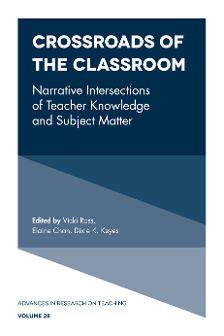
Index
ISBN: 978-1-78635-797-7, eISBN: 978-1-78635-796-0
ISSN: 1479-3687
Publication date: 25 April 2017
Citation
(2017), "Index", Crossroads of the Classroom (Advances in Research on Teaching, Vol. 28), Emerald Publishing Limited, Leeds, pp. 295-301. https://doi.org/10.1108/S1479-368720160000028021
Publisher
:Emerald Publishing Limited
Copyright © 2017 Emerald Publishing Limited
INDEX
- Prelims
- Teachers’ Stories of Navigating the Intersection of Subject Matter and Teacher Knowledge
- Section I: Entering the Crossroads through Stories at the Elementary Level
- Variegated Stories of Professional Development: Striking A/N IM/Balance between Science and Mathematics Content Knowledge and Teacher Knowledge
- Stories and Statistics: A Mixed Picture of Gender Equity in Mathematics
- A Glimpse into the Future: Practice Teaching in Fifth-grade Math
- Choosing the Best Alternative: The Branching Pathways of Consequences in Social Studies Curriculum Choice-Making
- Section II: Entering the Crossroads through Stories from the Secondary Level
- Sing it Over: Meditations on “Best-Loved Self” and Sustaining in Secondary English Language Arts
- Teaching that “Promotes Diversity”: The Potential of Disruptive Narratives
- Stories of an English Language Arts Teacher in a High Need Secondary School: A Narrative Inquiry into Her Best-Loved Self
- Health, Physical Education Content, and Teacher Knowledge/Identity
- Section III: Entering the Crossroads through Stories from Teacher Preparation
- A Narrative Inquiry of Other in Special Education: Tensions of Subject Matter Knowledge in Relation to Teacher Knowledge
- Interweaving Narratives of Personal and Professional Selves of a Beginning Teacher in India
- “Traditional Teaching Method Still Holds Water”: Narrative Inquiry of Student Teachers’ Professional Identities at the Intersection of Teacher Knowledge and Subject Matter Knowledge
- Indigenous Education, Relational Pedagogy, and Autobiographical Narrative Inquiry: A Reflective Journey of Teaching Teachers
- Narrative Resonance among Stories: Crossroads of the Classroom, Curriculum-Makers, and Complexities of Deliberation
- About the Authors
- Index